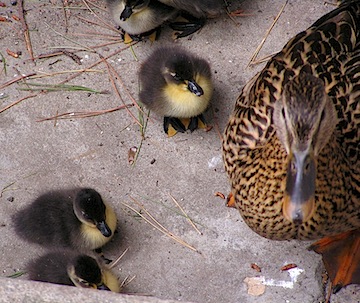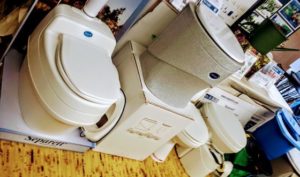 A mallard duck and her six chicks appeared Thursday in our cellar stairwell. Here’s a link to photos.
A mallard duck and her six chicks appeared Thursday in our cellar stairwell. Here’s a link to photos.
They were darling. Mother duck and two of the chicks were able to hop up the stairs to a tray of water and bowls of oats and spinach seed heads I left at the head of the stairs. Our neighbors threw pieces of bread to them, although this isn’t recommended due to the chicks’ delicate digestion. Worried about raccoons preying on them, I called the Humane Society’s wildlife agent, who told me it was best for the ducks to find their own way out and over to the creek. I placed a wood plank over the steps, hoping they’d use it as a ramp. But it was too slippery: I watched from the balcony as one duckling hopped up 2 steps then onto the ramp, only to slide to the ground.
This would have been amusing if I didn’t go down later and see that 2 of the ducklings had died overnight, their little bodies in each corner.
I feared they died of dehydration, so I placed the tray of water down next to the ducks.
Later that day, we saw a cat scaling the fence with two ducklings in its mouth. Mother duck ran out squawking and 1 duckling hopped up the steps and followed, but the remaining duckling couldn’t ascend stairs or ramp. This went on for awhile; I could see mom duck and duckling were ready to vacate but waited for the small one to hop up the steps. It frantically peeped and scurried about but couldn’t manage to hop up onto the step.
I considered picking up the duckling and setting it next to mom, but I feared it would be rejected or the chick would die of fright. So I called the wildlife rescue agent, Olivia. She came out with a big net and some cardboard crates. As she descended the stairs, mother duck made an impressive squawking and flew up and out, marching away to draw the agent away from her chicks. Olivia followed, and the duck flew off. The agent picked up the 2 ducklings, placed them in the box. She assured me that the sight of dead ducks at the foot of the stairs “lays it all out. The ducklings will probably die if they stay here.” She said the two she picked up would be put in an incubator at the shelter and then brought to a wildlife refuge. “This way they will make it to adulthood.”
Twenty minutes after she left, mother duck flew back and began searching for her brood with questioning clucking. This broke my heart. I left a message with the humane society.
The next day, they let me know the ducks are hybrids–half mallard and half domestic–so will not be re-introduced to the wild. They’ll likely go to a farm. I’m unsure what this means—will they be offered to a farm that wants cute ducks around, as one often sees in Massachusetts?
This whole saga reported by me on my Facebook page drew several sympathetic comments. I decided I should have put the ducklings in a basket and walked slowly to the creek, allowing mother duck to follow me. But they likely would have fallen prey to the same cat or the raccoon. Perhaps that was a risk worth taking. Obviously some ducks dodge predation in our creekside neighborhood–the mother duck is proof–but it’s hard to know when to let nature have its way and when to try to engineer the outcome. As Mary Shimp commented, “with nature, there’s a fine line between ‘helping’ and ‘interfering.'”

